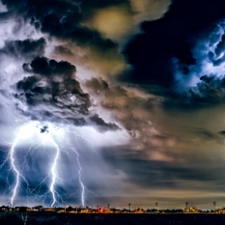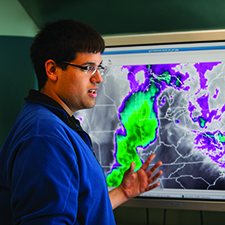EAPS faculty and students use observations and numerical modeling to better understand the physics, predictability and impacts of extreme weather systems, including thunderstorms, tornadoes, and tropical cyclones, and their variability within the climate system.

Extreme Weather

Climate Dynamics
The fundamental physics and processes of the regional and large-scale climate system and its variability (such as monsoons, El Niño, and the jet stream), and intraseasonal variability are topics of research by our faculty and students.

Surface-ATMS Interactions
Select EAPS faculty and students study the exchange of energy and matter between the atmosphere and the Earth’s surface, including sea, land, and vegetation.
Atmospheric Science News
Wildfire smoke lofted into atmosphere could affect Earth's climate
12-15-2025
Phys — Some wildfires are so intense, they create their own weather—thunderstorms driven by heat that hurtle smoke as high as 10 miles into the sky like giant chimneys. When these smoke plumes reach the thin, calm air of the upper troposphere and lower stratosphere, they can persist for weeks or even months—yet their exact effects on Earth's climate aren't well known because they're difficult to capture and measure. EAPS's Daniel Cziczo is a part of this research team.
Space pollution levels in the atmosphere are rocketing
11-19-2025
Chemical and Engineering News — The adage “what goes up must come down” is proving problematic in the space age. As more rockets and satellites in low Earth orbit burn up in the atmosphere at the end of their lives, the amount of introduced vapors and particulate matter there is dramatically rising. EAPS's Dan Cziczo was quoted in the article.
Purdue Leads NSF-Funded Midwest Agrivoltaics Incubator to Boost Rural Energy and Economic Resilience to Extreme Weather
11-19-2025
Rural communities across the Midwest, whose agricultural economies and energy infrastructure are frequently threatened by extreme weather events such as hailstorms, heat waves and high winds, are getting a new lifeline through a National Science Foundation–funded project at Purdue University. EAPS's Dan Chavas is one of Purdue's experts on the project.
Northern lights make rare appearance in Greater Lafayette due to sun positioning
11-13-2025
Star City TV — Folks in the Greater Lafayette area got a surprise view of the aurora borealis Tuesday night. Dr. Cauê Borlina, a professor in earth atmospheric and planetary sciences at Purdue, said seeing the northern lights is unique for Indiana, but this is peak time for Hoosiers to see the lights because of the sun’s position.
Fire in the sky: Strong summer storms in the Midwest send wildfire smoke into the previously pristine stratosphere
10-22-2025
Aerosols and burning biomass may affect heating and energy absorption in the ozone, leading to faster warming and unexpected climate effects. EAPS's Dan Cziczo led the research team in conjunction with research scientist Xiaoli Shen.
